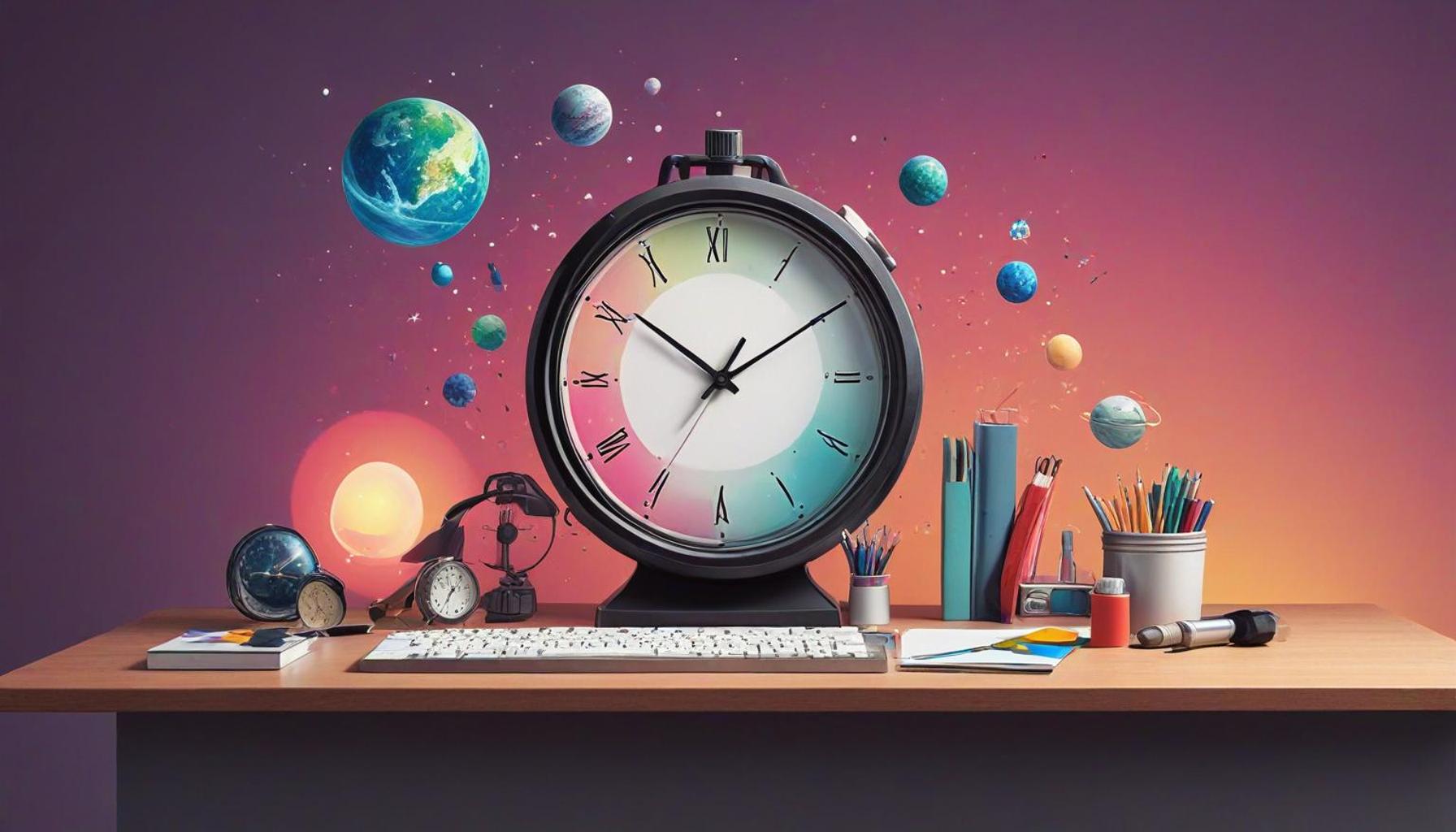Creating Space for the Essential: Minimalism Techniques to Enhance Focus and Efficiency in Time Management

The Power of Minimalism in Time Management
In a world inundated with distractions, the clarity of thought and purpose can feel like a rare commodity. The shiny notifications on our smartphones, the endless lists of to-dos, and the plethora of choices can lead to mental fatigue and inefficiency. This is where the philosophy of minimalism emerges as a beacon of hope, guiding us toward a more focused and intentional life. By stripping away the non-essential and embracing simplicity, we can enhance our productivity and reclaim our time.
Applying minimalism to time management involves a conscious choice to prioritize the tasks that align with our goals and values. Here are some key techniques that can significantly boost your efficiency:
- Declutter your schedule: Evaluate your daily tasks and identify the activities that consume time without offering value. For instance, attending meetings that could be resolved through a quick email or chat can be a waste of effort. By eliminating such non-essential commitments, you free up time for what truly matters.
- Set clear priorities: Use techniques like the Eisenhower Matrix, which categorizes tasks into four quadrants based on urgency and importance. Focus on completing critical goals first—whether that’s a work project, personal growth, or family time. For example, if learning a new skill is important to you, allocate time blocks in your calendar dedicated solely to this pursuit.
- Limit distractions: In an age where multitasking is often celebrated, creating a dedicated workspace can lead to improved focus. Establishing boundaries, like turning off social media notifications during work hours, can significantly enhance your concentration. Additionally, consider using productivity tools that help track time spent on tasks, allowing you to be more mindful of where your attention goes.
By implementing these practices, you can create space for the essential in your life. A simpler environment often leads to sharper focus, as your mind is not cluttered with overwhelming options or tasks. Furthermore, studies indicate that minimalism can have profound implications for mental health, reducing anxiety and fostering a sense of calm. Research from organizations like the American Psychological Association highlights that individuals who engage in less multitasking report higher levels of satisfaction and reduced stress.
Embracing minimalism in time management is not just about productivity; it’s about crafting a life that reflects your values and passions. As you embark on this journey, consider how you can shed the unnecessary and cultivate an environment where focus and efficiency thrive. Explore practical methods that resonate with your unique lifestyle, and begin to foster a life that is rich in purpose, rather than one filled with clutter and chaos.
DIVE DEEPER: Click here to boost your productivity

Streamlining Your Tasks for Maximum Impact
Minimalism in time management revolves around the art of streamlining tasks to focus on what truly matters. One of the first steps in this journey is to conduct a thorough audit of your daily commitments. Take a moment to reflect on your calendar for the past month. Have you been attending events or meetings that yield little in terms of return on investment? Recognizing these time sinks is crucial. Research from the Harvard Business Review emphasizes that professionals often spend more than a quarter of their workweek on unproductive meetings. By eliminating such time-wasters, you create valuable space for essential tasks that contribute meaningfully to your goals.
A practical application of this concept includes creating a “must-do” list alongside your traditional to-do list. This new approach differentiates between tasks based on strategic importance rather than urgency alone. This technique lends clarity to your daily objectives and helps prevent the trap of reacting to urgent but inconsequential tasks that may arise throughout the day.
Time Blocking: A Method for Intentional Scheduling
Another minimalism technique that resonates well with modern professionals is time blocking. This method involves dividing your day into distinct blocks dedicated to specific tasks or types of work. By consistently following this structure, you cultivate a sense of rhythm in your workday, allowing for more profound focus on single tasks without the mental overload often associated with multitasking.
To implement time blocking effectively, consider these steps:
- Identify high-priority tasks: Every week, assess your projects and determine which are time-sensitive and essential for your long-term goals.
- Create dedicated blocks: Allocate 30 to 90-minute intervals for these tasks in your calendar, ensuring minimal interruptions during this dedicated focus time.
- Review and adjust: At the end of each week, reflect on what has been accomplished. Adjust your focus blocks for the following week to better align with your evolving priorities.
The cumulative effect of these practices is transformational. Studies suggest that professionals who incorporate time blocking report increased productivity levels and enhanced clarity in their working objectives. When you deliberately allocate time for tasks that align with your goals, you can *cultivate a profound focus* and achieve a greater sense of accomplishment throughout your day.
By embracing these minimalism techniques, you start to foster an environment where time is viewed as a precious resource—one that should be guarded zealously. As you create space for the essential in your life, you’ll discover that productivity isn’t simply about doing more; it’s about doing what truly matters with intention and clarity.
| Advantages | Key Features |
|---|---|
| Enhanced Focus | By eliminating distractions, minimalism creates a conducive environment for concentrated work. |
| Increased Efficiency | Streamlined tasks through prioritization lead to effective time management and reduced overwhelm. |
| Reduced Stress | A minimalist approach helps in decluttering not only physical space but also mental space, fostering tranquility. |
| Simplified Decision-Making | Less distraction allows for clearer decision-making processes, ensuring that important choices are timely and informed. |
Minimalism is all about creating space for what truly matters, which can significantly enhance our focus and efficiency in time management. As we incorporate minimalism techniques into our daily lives, we develop a clearer path to manage our time effectively. It promotes conscious choices that not only declutter our environment but also streamline our thought processes. Discovering the delicate balance between essential and non-essential elements supports a life that prioritizes significant tasks, allowing us to navigate our days with greater clarity and purpose. Embracing a minimalist mindset serves as a profound tool in enhancing our overall efficiency.
DISCOVER MORE: Click here to learn about living with less
Prioritizing with the 80/20 Rule
In the pursuit of enhanced focus and efficiency, one of the most potent minimalism techniques you can employ is the 80/20 rule, or the Pareto Principle. This principle posits that approximately 80% of your results come from 20% of your efforts. By identifying which tasks and activities make up that critical 20%, you can concentrate your energy on the most impactful areas of your work.
To effectively apply this rule, start by assessing your past achievements. Look at your projects and identify the specific actions that have resulted in significant outcomes. For instance, if you lead a team, consider which initiatives garnered the most sales or customer satisfaction. Once you’ve pinpointed these high-impact activities, prioritize them in your schedule. This method not only allows you to spend your time more wisely but also brings clarity to your daily operations, ensuring that your energy is directed toward what counts.
Decluttering Your Digital Space
Another facet of minimalism in time management is decluttering your digital environment. In our tech-driven society, the digital landscape can become overwhelming, creating distractions that hinder productivity. Take a step back and evaluate your digital tools, applications, and documents. Are they helping you achieve your goals, or are they merely contributing to information overload?
Start with an email audit: unsubscribe from newsletters that no longer serve you and create folders to categorize important messages. On platforms like Trello or Asana, evaluate your ongoing projects and eliminate outdated tasks that no longer align with your objectives. Interestingly, a study published in the Journal of Information Technology indicated that workers spend an average of 28% of their workweek dealing with emails. By streamlining your digital communications and categorizing your tasks, you empower yourself to focus on what’s essential.
Creating a Distraction-Free Zone
Finally, while assessing the physical and digital aspects of your environment, don’t overlook the importance of a distraction-free zone for enhancing focus. This zone could be a specific corner of your home or a designated office space where clutter is minimized, and interruptions are controlled. According to a report from the American Psychological Association, even minor distractions can significantly impact cognitive performance. Therefore, consider implementing tactics such as:
- Noise-canceling headphones: Create an auditory barrier to external noises while fostering an atmosphere of concentration.
- Physical organization: Keep your workspace tidy and limit the number of items in sight to those necessary for your immediate tasks.
- Set boundaries: Communicate your focus hours to colleagues and family members, establishing clear guidelines around interruptions.
As you cultivate a distraction-free zone, you will find that your ability to engage deeply with tasks significantly improves. This environment not only supports your focus but also promotes a more meditative state of productivity, allowing for a deeper connection to your work and, ultimately, greater satisfaction in your accomplishments.
By integrating the 80/20 rule, decluttering your digital space, and creating a distraction-free zone into your daily routine, you can elevate your time management practices. These minimalist techniques emphasize that creating space for the essential is about eliminating the non-essentials and harnessing your energies toward meaningful work that enhances your productivity and effectiveness.
DISCOVER MORE: Click here to learn how minimalism can ease your mind
Conclusion
In a world inundated with distractions and overwhelming tasks, adopting a minimalist approach to time management can be a game-changer. By implementing strategies such as the 80/20 rule, you empower yourself to focus on the activities that yield the most significant results. This targeted prioritization not only streamlines your schedule but also minimizes the busywork that often consumes our precious time.
Furthermore, decluttering your digital space is vital in maintaining clarity and efficiency. A well-organized digital environment mitigates the chaos caused by constant notifications and cluttered inboxes, enabling you to direct your focus where it truly matters. Studies highlight the loss of productivity through digital clutter, underlining the necessity of this minimalist technique in our tech-centric lives.
Finally, creating a distraction-free zone is crucial for fostering a productive atmosphere. By physically and psychologically removing interruptions, you allow for deeper engagement with your work—a fundamental element of efficiency. Such an environment not only enhances focus but also nurtures a sense of accomplishment, empowering you to tackle your goals effectively.
In conclusion, integrating these minimalism techniques into your routine provides a pathway to reclaiming your time and boosting productivity. By discerning the essential from the non-essential, you lay the groundwork for a more focused, efficient, and rewarding work experience. As you embark on this journey of simplification and purpose, remember that the art of minimalism is not just about what you lose, but more importantly, it’s about what you gain in clarity, focus, and fulfillment.
Related posts:
Digital Minimalism: Strategies for Managing Time in a Connected World
Minimalist Work Rhythms: Strategizing Your Time with Fewer Interruptions
Simplifying Decision Making: The Role of Minimalism in Reducing Time Spent on Choices
Creating Efficient Routines: The Intersection of Minimalism and Time Management
Master Time Management Transform Your Priorities with Minimalism
Minimalism in Daily Life: Tips for Organizing Your Routine and Maximizing Your Time

Linda Carter is a writer and organization expert specializing in minimalism and personal organization. With extensive experience helping individuals create clutter-free, functional spaces and adopt mindful habits, Linda shares her knowledge on our platform. Her goal is to empower readers with practical advice and strategies to simplify their lives, stay organized, and achieve a sense of calm and balance in their daily routines.